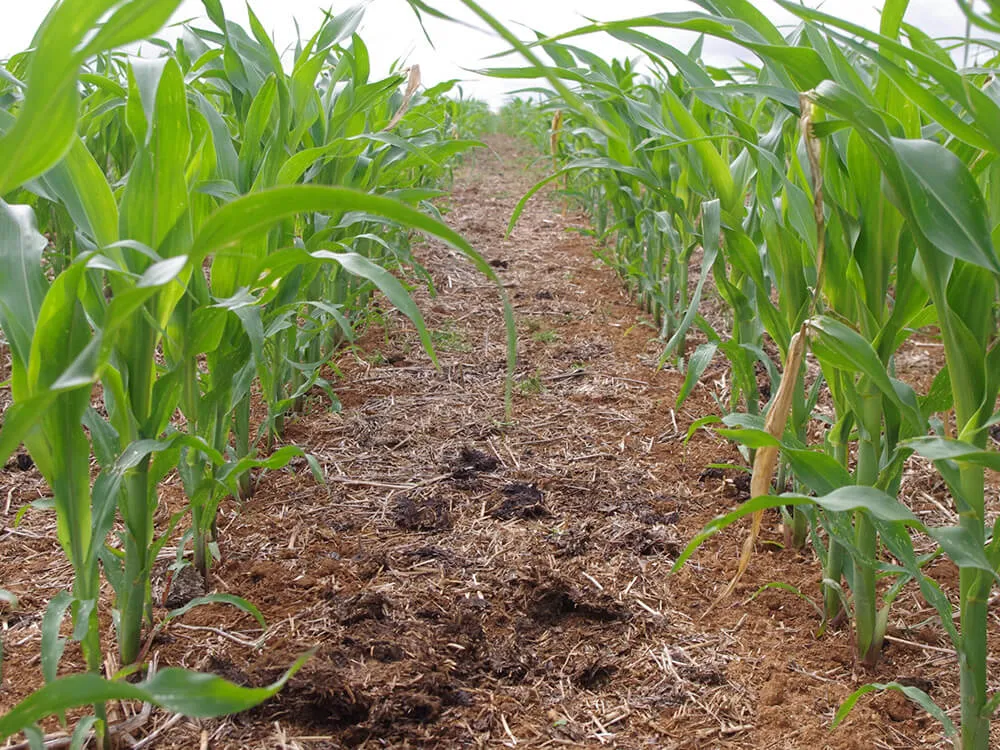





Pascal wonders to what extent it is possible to simplify tillage in seed corn, without impacting yield or quality, and without increasing herbicide consumption. Simplifying tillage, which minimizes the mineralisation of organic matter and thus improves the carbon balance, poses a number of technical challenges for the establishment of spring crops (seedbed, fertility, warming, humidity and weed management).
For Benoît Chorro, the strip-till technique is the most suitable for this type of crop, although he points out that reducing tillage is first and foremost a question of soil condition, rather than a technical issue, and can therefore only be considered after a precise diagnosis of the soil structure.
Benoit Chorro insists that if it is implemented in unsuitable conditions, "simplifying tillage entails a series of risks, including soil contamination of plots and crop establishment failures, which should not be underestimated". The first step is therefore to carry out a structural diagnosis using a spade test, a 3D profile or a soil pit. The two conditions to be met are:
If these two conditions are not met, mechanical cultivation can help to re-establish a better environment for germination and crop development.
Where the soil is well-structured, simplified tillage can be envisaged. While direct drilling of maize (seed or grain) into living cover is still not a widespread technique, given the limitations of direct drilling equipment in these conditions (presence of debris, etc.), strip-tilling, which consists of preparing the seed line while leaving the inter-row intact, shows very good results in living cover.
Broad bean cover is generally favoured, as this species is sensitive to frost and has blackish residues that help to warm the soil and fix nitrogen from the air. This legume cover also provides better weed control thanks to the formation of a mulch, and can supply between thirty and forty units of nitrogen to the following crop when it breaks down. Strip-till creates hyper-favourable conditions for maize growth (structure, removal of debris and warming), but it is important not to overlook the benefits of localised fertilisation at sowing to compensate for lower mineralisation under ultra-simplified tillage.
Finally, Benoit Chorro gives an example of a typical strip-till maize planting in a faba bean canopy, in south-west France:
Broad beans are generally destroyed after sowing maize, either chemically or by rolling. It should also be noted that several types of strip preparation are possible, depending mainly on soil type. In loam soils, a tine can be used at a depth of around fifteen to twenty centimeters, but in clay soils only shallow tillage elements can be used in the spring.
*satellite positioning technology
Provided the soil is well-structured, strip-tilling is the most effective way of planting maize with minimum tillage, because it combines plant cover with low soil disturbance, while ensuring that the maize emerges and develops properly.


Pascal wonders to what extent it is possible to simplify tillage in seed corn, without impacting yield or quality, and without increasing herbicide consumption. Simplifying tillage, which minimizes the mineralisation of organic matter and thus improves the carbon balance, poses a number of technical challenges for the establishment of spring crops (seedbed, fertility, warming, humidity and weed management).
For Benoît Chorro, the strip-till technique is the most suitable for this type of crop, although he points out that reducing tillage is first and foremost a question of soil condition, rather than a technical issue, and can therefore only be considered after a precise diagnosis of the soil structure.
Benoit Chorro insists that if it is implemented in unsuitable conditions, "simplifying tillage entails a series of risks, including soil contamination of plots and crop establishment failures, which should not be underestimated". The first step is therefore to carry out a structural diagnosis using a spade test, a 3D profile or a soil pit. The two conditions to be met are:
If these two conditions are not met, mechanical cultivation can help to re-establish a better environment for germination and crop development.
Where the soil is well-structured, simplified tillage can be envisaged. While direct drilling of maize (seed or grain) into living cover is still not a widespread technique, given the limitations of direct drilling equipment in these conditions (presence of debris, etc.), strip-tilling, which consists of preparing the seed line while leaving the inter-row intact, shows very good results in living cover.
Broad bean cover is generally favoured, as this species is sensitive to frost and has blackish residues that help to warm the soil and fix nitrogen from the air. This legume cover also provides better weed control thanks to the formation of a mulch, and can supply between thirty and forty units of nitrogen to the following crop when it breaks down. Strip-till creates hyper-favourable conditions for maize growth (structure, removal of debris and warming), but it is important not to overlook the benefits of localised fertilisation at sowing to compensate for lower mineralisation under ultra-simplified tillage.
Finally, Benoit Chorro gives an example of a typical strip-till maize planting in a faba bean canopy, in south-west France:
Broad beans are generally destroyed after sowing maize, either chemically or by rolling. It should also be noted that several types of strip preparation are possible, depending mainly on soil type. In loam soils, a tine can be used at a depth of around fifteen to twenty centimeters, but in clay soils only shallow tillage elements can be used in the spring.
*satellite positioning technology
Provided the soil is well-structured, strip-tilling is the most effective way of planting maize with minimum tillage, because it combines plant cover with low soil disturbance, while ensuring that the maize emerges and develops properly.
